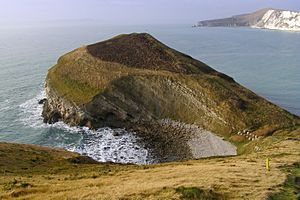Worbarrow Tout facts for kids
Worbarrow Tout is a cool piece of land that sticks out into the sea. You can find it at the east end of Worbarrow Bay in Dorset, on the south coast of England. It's about 6 kilometers (4 miles) south of Wareham and 16 kilometers (10 miles) west of Swanage. Right next to it, on its east side, is a small beach called Pondfield Cove.
The word "tout" means "lookout," which makes sense because it's a great spot to see the ocean! Worbarrow Tout used to be connected to a bigger cliff called Gad Cliff. But over a long time, the sea has worn away the land, almost completely separating them.
How Worbarrow Tout Was Formed
Worbarrow Tout has a unique, pointy shape. If you look closely at its cliffs, you can see layers of rock that are tilted at sharp angles. These tilted layers show how the rocks in this area were folded and bent.
This amazing folding happened because of huge forces from deep inside the Earth. About 30 million years ago, the African and European continents slowly crashed into each other. This giant collision pushed and twisted the rocks here.
The older rocks, like the Chalk, are found further back in the bay. These Chalk rocks are between 85 and 145 million years old. The rocks that form Worbarrow Tout itself are even older! They are the Portland limestones, which are about 150 million years old, and the Purbeck Beds, which are about 147 million years old. These older rocks face the sea at the front of the bay.
Discovering Fossils and Sea Life
The Jurassic Coast is famous for its many important fossil sites, and Worbarrow Tout is one of them! The rocks here, especially the Purbeck limestones and shales, were formed in ancient lagoons.
These rocks contain amazing clues about life from millions of years ago. You can find dinosaur footprints here! There are also lots of fossils of creatures that lived in salty water, like bivalves (shellfish with two shells), gastropods (like snails), and tiny ostracods.
Under the water, the rocky seabed near Worbarrow Tout is home to a special and rare type of coral. It's called the Pink sea fan. This coral grows very slowly and is protected. It's one of only two types of fan-corals you can find in British waters, making this a very important place for marine life.


